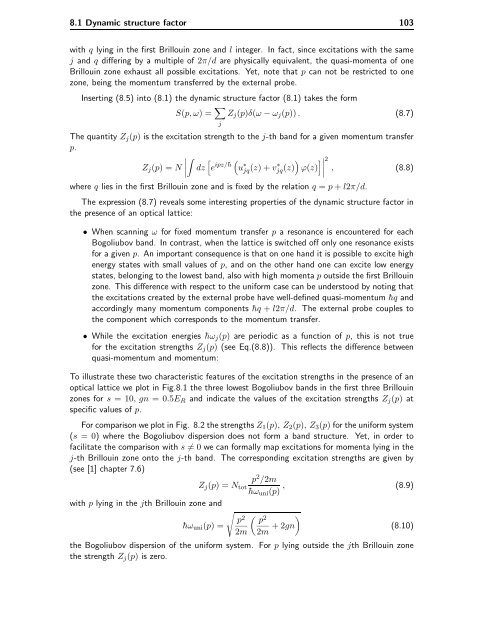Bose-Einstein Condensates in Rotating Traps and Optical ... - BEC
Bose-Einstein Condensates in Rotating Traps and Optical ... - BEC
Bose-Einstein Condensates in Rotating Traps and Optical ... - BEC
Create successful ePaper yourself
Turn your PDF publications into a flip-book with our unique Google optimized e-Paper software.
8.1 Dynamic structure factor 103<br />
with q ly<strong>in</strong>g <strong>in</strong> the first Brillou<strong>in</strong> zone <strong>and</strong> l <strong>in</strong>teger. In fact, s<strong>in</strong>ce excitations with the same<br />
j <strong>and</strong> q differ<strong>in</strong>g by a multiple of 2π/d are physically equivalent, the quasi-momenta of one<br />
Brillou<strong>in</strong> zone exhaust all possible excitations. Yet, note that p can not be restricted to one<br />
zone, be<strong>in</strong>g the momentum transferred by the external probe.<br />
Insert<strong>in</strong>g (8.5) <strong>in</strong>to (8.1) the dynamic structure factor (8.1) takes the form<br />
S(p, ω) = <br />
Zj(p)δ(ω − ωj(p)) . (8.7)<br />
j<br />
The quantity Zj(p) is the excitation strength to the j-thb<strong>and</strong>foragivenmomentumtransfer<br />
p.<br />
<br />
<br />
Zj(p) =N ipz/¯h<br />
dz e u ∗ jq(z)+v ∗ <br />
jq(z) ϕ(z)<br />
2 , (8.8)<br />
where q lies <strong>in</strong> the first Brillou<strong>in</strong> zone <strong>and</strong> is fixed by the relation q = p + l2π/d.<br />
The expression (8.7) reveals some <strong>in</strong>terest<strong>in</strong>g properties of the dynamic structure factor <strong>in</strong><br />
the presence of an optical lattice:<br />
• When scann<strong>in</strong>g ω for fixed momentum transfer p a resonance is encountered for each<br />
Bogoliubov b<strong>and</strong>. In contrast, when the lattice is switched off only one resonance exists<br />
for a given p. An important consequence is that on one h<strong>and</strong> it is possible to excite high<br />
energy states with small values of p, <strong>and</strong> on the other h<strong>and</strong> one can excite low energy<br />
states, belong<strong>in</strong>g to the lowest b<strong>and</strong>, also with high momenta p outside the first Brillou<strong>in</strong><br />
zone. This difference with respect to the uniform case can be understood by not<strong>in</strong>g that<br />
the excitations created by the external probe have well-def<strong>in</strong>ed quasi-momentum ¯hq <strong>and</strong><br />
accord<strong>in</strong>gly many momentum components ¯hq + l2π/d. The external probe couples to<br />
the component which corresponds to the momentum transfer.<br />
• While the excitation energies ¯hωj(p) are periodic as a function of p, this is not true<br />
for the excitation strengths Zj(p) (see Eq.(8.8)). This reflects the difference between<br />
quasi-momentum <strong>and</strong> momentum:<br />
To illustrate these two characteristic features of the excitation strengths <strong>in</strong> the presence of an<br />
optical lattice we plot <strong>in</strong> Fig.8.1 the three lowest Bogoliubov b<strong>and</strong>s <strong>in</strong> the first three Brillou<strong>in</strong><br />
zones for s =10,gn=0.5ER <strong>and</strong> <strong>in</strong>dicate the values of the excitation strengths Zj(p) at<br />
specific values of p.<br />
For comparison we plot <strong>in</strong> Fig. 8.2 the strengths Z1(p), Z2(p), Z3(p) for the uniform system<br />
(s =0) where the Bogoliubov dispersion does not form a b<strong>and</strong> structure. Yet, <strong>in</strong> order to<br />
facilitate the comparison with s = 0we can formally map excitations for momenta ly<strong>in</strong>g <strong>in</strong> the<br />
j-th Brillou<strong>in</strong> zone onto the j-th b<strong>and</strong>. The correspond<strong>in</strong>g excitation strengths are given by<br />
(see [1] chapter 7.6)<br />
p<br />
Zj(p) =Ntot<br />
2 /2m<br />
, (8.9)<br />
¯hωuni(p)<br />
with p ly<strong>in</strong>g <strong>in</strong> the jth Brillou<strong>in</strong> zone <strong>and</strong><br />
<br />
p<br />
¯hωuni(p) =<br />
2 <br />
p2 2m 2m +2gn<br />
<br />
(8.10)<br />
the Bogoliubov dispersion of the uniform system. For p ly<strong>in</strong>g outside the jth Brillou<strong>in</strong> zone<br />
the strength Zj(p) is zero.




